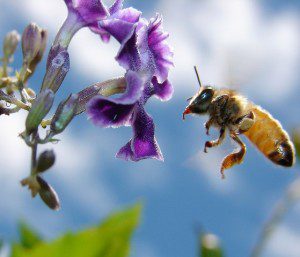By Richard Schiffman – blogs.reuters.com
If it were a novel, people would criticize the plot for being too far-fetched – thriving colonies disappear overnight without leaving a trace, the bodies of the victims are never found. Only in this case, it’s not fiction: It’s what’s happening to fully a third of commercial beehives, over a million colonies every year. Seemingly healthy communities fly off never to return. The queen bee and mother of the hive is abandoned to starve and die.
Thousands of scientific sleuths have been on this case for the last 15 years trying to determine why our honey bees are disappearing in such alarming numbers. “This is the biggest general threat to our food supply,” according to Kevin Hackett, the national program leader for the U.S. Department of Agriculture’s bee and pollination program.
Until recently, the evidence was inconclusive on the cause of the mysterious “colony collapse disorder” (CCD) that threatens the future of beekeeping worldwide. But three new studies point an accusing finger at a culprit that many have suspected all along, a class of pesticides known as neonicotinoids.
[pro_ad_display_adzone id=”110028″]
In the U.S. alone, these pesticides, produced primarily by the German chemical giant Bayer and known as “neonics” for short, coat a massive 142 million acres of corn, wheat, soy and cotton seeds. They are also a common ingredient in home gardening products.
Research published last month in the prestigious journal Science shows that neonics are absorbed by the plants’ vascular system and contaminate the pollen and nectar that bees encounter on their rounds. They are a nerve poison that disorient their insect victims and appear to damage the homing ability of bees, which may help to account for their mysterious failure to make it back to the hive.
Another study published in the American Chemical Society’s Environmental Science and Technology journal implicated neonic-containing dust released into the air at planting time with “lethal effects compatible with colony losses phenomena observed by beekeepers.”
Purdue University entomologists observed bees at infected hives exhibiting tremors, uncoordinated movement and convulsions, all signs of acute insecticide poisoning. And yet another study conducted by scientists at the Harvard School of Public Health actually re-created colony collapse disorder in several honeybee hives simply by administering small doses of a popular neonic, imidacloprid.
But scientists believe that exposure to toxic pesticides is only one factor that has led to the decline of honey bees in recent years. The destruction and fragmentation of bee habitats, as a result of land development and the spread of monoculture agriculture, deprives pollinators of their diverse natural food supply. This has already led to the extinction of a number of wild bee species. The planting of genetically modified organism (GMO) crops – some of which now contain toxic insecticides within their genetic structure – may also be responsible for poisoning bees and weakening their immune systems.
Every spring millions of bee colonies are trucked to the Central Valley of California and other agricultural areas to replace the wild pollinators, which have all but disappeared in many parts of the country. These bees are routinely fed high-fructose corn syrup instead of their own nutritious honey. And in an effort to boost productivity, the queens are now artificially inseminated, which has led to a disturbing decline in bee genetic diversity. Bees are also dusted with chemical poisons to control mites and other pathogens that have flourished in the overcrowded commercial colonies.
In 1923, Rudolph Steiner, the German founder of biodynamic agriculture, a precursor of the modern organic movement, predicted that within a hundred years artificial industrial techniques used to breed honey bees would lead to the species’ collapse. His prophecy was right on target!
Honey bees have been likened to the canaries in the coal mine. Their vanishing is nature’s way of telling us that conditions have deteriorated in the world around us. Bees won’t survive for long if we don’t change our commercial breeding practices and remove deadly toxins from their environment. A massive pollinator die-off would imperil world food supplies and devastate ecosystems that depend on them. The loss of these creatures might rival climate change in its impact on life on earth.
Still, this is a disaster that does not need to happen. Germany and France have already banned pesticides that have been implicated in the deaths of bees. There is still time to save the bees by working with nature rather than against it, according to environmentalist and author Bill McKibben:
“Past a certain point, we can’t make nature conform to our industrial model. The collapse of beehives is a warning – and the cleverness of a few beekeepers in figuring out how to work with bees not as masters but as partners offers a clear-eyed kind of hope for many of our ecological dilemmas.”
[pro_ad_display_adzone id=”110027″]







